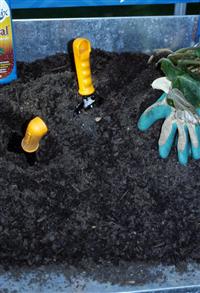If you are interested in horticulture and would like to help others this course could be the direction you seek.
Horticultural therapists use horticultural activities as a tool for helping disadvantaged people
Therapy may be focused on either:
- Improving or maintaining muscle function, and other aspects of physical wellbeing
psychological wellbeing (eg. helping elderly people stay active in their declining years, helping disabled people to have a sense of worth, providing an opportunity for social interaction, etc)
- Providing people with impaired capabilities with an opportunity for employment (eg. In a sheltered workshop
- Providing a pathway to rehabilitation; or perhaps providing an alternative lifestyle.Ddeveloping practical skills
- Developing social skills
- Rehabilitation of physically or psychologically damaged individuals
 Sometimes programs are developed with a group focus, and at other times they are tailored for the needs of an individual. The therapist may work with a small group, or they may work one on one with individuals. They often work closely with health care professionals or other service providers (eg. A physiotherapist may better understand the physical needs and limitations of an accident victim. A horticultural therapist working with a physiotherapist can develop a program of horticultural activities for an individual, that is tailored to their needs and leads to effective rehabilitation. The benefit of this “joint” approach may be that the patient can be prescribed a pathway to recovery that does not seem like exercise, and which the patient is more motivated to adhere to).
Sometimes programs are developed with a group focus, and at other times they are tailored for the needs of an individual. The therapist may work with a small group, or they may work one on one with individuals. They often work closely with health care professionals or other service providers (eg. A physiotherapist may better understand the physical needs and limitations of an accident victim. A horticultural therapist working with a physiotherapist can develop a program of horticultural activities for an individual, that is tailored to their needs and leads to effective rehabilitation. The benefit of this “joint” approach may be that the patient can be prescribed a pathway to recovery that does not seem like exercise, and which the patient is more motivated to adhere to).
A horticultural therapist needs to be part horticulturist, part health care worker, part counsellor, and sometimes other things beyond these.
They can work in medical or health care institutions (eg. Hospitals, Homes for Elderly), community centres, special schools (eg. for people with disabilities), Sheltered Workshop, Prisons, or any other relevant situation.
Horticultural therapy is used for people with a wide range of cognitive, physical and social skills, including those people:
- Suffering from stroke
- Suffering from heart disease
- With sight impairment (the blind and the partially sighted)
- With dementia
- With learning disabilities
- With physical disabilities (including amputees)
- With underdeveloped social skills
- Chronically unemployed
- Disengaged teenagers
- In substance abuse recovery
- Recovering from illness
- Coming to terms with grief
- Adjusting after personal difficulties in their lives
- With terminal illness
- Rehabilitating after a period in hospital
- With physical restrictions - such as the elderly
- Children – in general.
Lesson Structure
There are 9 lessons in this course:
- Scope and Nature of Horticultural Therapy
- Understanding Disabilities and Communicating with people with disabilities
- Communication, Teaching and Counseling Skills
- Risk Management -Hygiene for vulnerable people, What extra risks are to be considered in a therapy situation.... chemical, physical
- Accessibility and Activities for people with Mobility issues (eg. wheelchairs, on crutches,
- Enabling the Disabled -with restricted motor skills
- Producing Things –Vegetables, Propagation, Fruit, Herbs
- Growing in Containers -Vertical gardens, pots, Hydroponics
- Creating a Therapeutic Garden
- Generating Income
Each lesson culminates in an assignment which is submitted to the school, marked by the school's tutors and returned to you with any relevant suggestions, comments, and if necessary, extra reading.
Course Duration: 100 hours
 WHAT ARE THE BENEFITS OF USING HORTICULTURAL THERAPY
WHAT ARE THE BENEFITS OF USING HORTICULTURAL THERAPY
There are many benefits to be gained from horticultural therapy. These benefits are both physical and psychological.
General Benefits
People of any age can participate in horticultural therapy.
The horticultural therapist can individualise the work they do with a person, according to their abilities, so activities in horticultural therapy should be accessible for all.
For example, work areas can be made more accessible for people who have difficulties with their back or bending, so that they do not have to bend over work areas. Work areas can be lowered so people in wheelchairs can use them. They can also be lowered so that children can work on benches and so on.
The location where horticultural therapy is carried out can also be individualised. For example, the area could be controlled so that children or vulnerable adults do not have access to dangerous plants or put plants in their mouths. Gardens can be made accessible for people with wheelchairs, mobility problems, sight difficulties and so on.
Physical Benefits
Horticultural therapy can help people to:
Improve their fine motor skills. We have fine and gross motor skills Gross motor skills involve our larger muscle groups, such as when we dig, run or jump. Fine motor skills involve the use of our smaller bones and muscles, as we would in handling secateurs, sowing seeds, writing and so on.
Increase muscular strength and muscle tone – being involved in gardening can help a person to increase their muscular strength. Even if they are not able to use some of their muscles, for example, if they are unable to use their legs, it can increase their muscle strength and tone in other areas, such as their arms, shoulders etc.
Increase range of motion – Having to move around, dig, prune, sowing and so on can help increase the range of motion a person has.
Improve coordination and balance – Being involved in gardening and horticultural therapy can help a person to improve their coordination and balance. Imagine digging, this requires the use of arms and legs, so requires a good range of coordination and balance. If a person cannot use their legs or arms, then the limbs that they do use will require increased strength and tone and also balance and coordination.
Therefore, horticultural therapy can increase a person’s physical health.
Psychological Benefits
Horticultural therapy also has psychological benefits:
It can help increase a person’s self esteem. For example, a person who does not feel they are good at things, perhaps they have disabilities or learning disabilities, being able to be involved in gardening and horticulture, and do it well, can increase their self esteem.
It can help increase their independence – It can help a person to learn new tasks, to work on their own, to learn more about plants and gardening. It can also help with their independence if they are able to transfer these skills to other environments and their own home. For example, growing plants and vegetables in their own home.
It can also increase the observation skills a person uses. They have to become aware of how plants grow, how seeds should be planted and so on.
Horticultural therapy can also allow a person to make choices. With some psychological conditions, such as some learning disabilities, a person may not have very much control over their own life, so being involved in horticultural therapy enables them to make choices and state their independence more than they have possibly in the past.
Horticultural therapy can increase a person’s problem solving skills – when to plant certain crops, how, how deep, what type of soil, what do they do in less than ideal situations and so on? It can also help them to consider more about their own abilities. People can show great initiative. What if they find digging hard? Or planting seeds hard? The person and the horticultural therapist can look at ways in which they can become more involved, so aiding their problem solving skills also.
It can also increase a person’s creativity, help them to think of how they do things, how they plant a garden, where is the best place to plant a particular flower, what would look best and so on.
Gardening and horticulture can also be a place where a person can let out their emotions or stress or anger. Exercise can be a good release of anger and emotion and there is obviously exercise involved in gardening. Also, thinking about the plants and soil and what you are doing can be a good distraction from a stressful situation.
Horticultural therapy can also have social benefits, allowing the person to interact socially with others, which can also increase their self esteem, social skills and speech and language skills.
By showing a commitment to living things, a person is taking responsibility for that work, that garden and also to working with others as part of a team or group.
It can also help a person to deal with success and failure. A person may have many filatures in their life, but gardening can help them to find ways to overcome failures. Because a plant does not flower one year or a vegetable crop does not grow as well as planned, this can be used to help the person to look at what they did (problem solving again) and how things could be improved. Was it the wrong soil? The wrong location? Was the weather too cold for the plants to survive? What could they do about that?
It enables a person to commune with nature and to feel the benefits of doing so.
It also allows the person to be inspired by others, to learn more about nature and their environment.
 Working as a Horticultural Therapist
Working as a Horticultural Therapist
Horticultural therapy is also often called 'gardening therapy' or 'garden therapy'. As with other forms of therapy, horticultural therapy is concerned with the physical, psychological and emotional well-being of its participants. Providing structured horticultural activities can not only help to focus the mind of a client, but can also offer valuable time to de-stress for carers.
Horticultural therapists use horticultural activities as a tool for helping disadvantaged people in a number of different ways including:
Improving or maintaining muscle function, and other aspects of physical wellbeing
- Psychological wellbeing (e.g. helping elderly people stay active in their declining years, helping disabled people to have a sense of worth, providing an opportunity for social interaction, etc.)
- Providing people with impaired capabilities an opportunity for employment (e.g. in a sheltered workshop)
- Providing a pathway to rehabilitation; or perhaps providing an alternative lifestyle
- Developing practical skills
- Developing social skills
- Rehabilitation of physically or psychologically damaged individuals
- Delaying the progression of Alzheimer's disease and other forms of dementia by keeping the mind active.
Where Do They Work?
They can work in medical or health care institutions (e.g. hospitals, homes for the elderly), community centres, special schools (e.g. for disabled or handicapped people), sheltered workshop, prisons, or any other relevant situation.
Some of these places of work are explained further as follows:
- Sheltered workshops – working with people who have intellectual or physical disabilities. Tasks might involve things like growing plants, perhaps in a plant nursery, producing fruit and vegetables, undertaking some sort of garden maintenance task, or something else which is horticulture-related. The sheltered workshop provides an opportunity for these people to be productive, and often to earn some level of income, in a sheltered situation.
- Rehabilitation centres or hospitals – conducting gardening activities that can contribute either mentally or physically to the rehabilitation of people following an illness or accident.
- Elderly care services – organising facilities and gardening activities in a retirement village or elderly care facility.
- Home visits - therapists may visit the homes of those with debilitating diseases or those undergoing rehabilitation.
OPPORTUNITIES
Opportunities arise for this type of work periodically in any place where you find disadvantaged people, including drug abuse victims, accident victims, disabled and handicapped people, the elderly, people with dementia, people suffering debilitating illnesses, etc.
Sometimes programs are developed with a group focus, and at other times they are tailored for the needs of an individual. The therapist may work with a small group, or they may work one-on-one with individuals. They often work closely with health care professionals or other service providers. For instance, a physiotherapist may better understand the physical needs and limitations of an accident victim. A horticultural therapist working with a physiotherapist can develop a programme of horticultural activities for an individual that is tailored to their needs and leads to effective rehabilitation. A horticultural therapist who is assisting a dementia sufferer might work in conjunction with an occupational therapist and a psychologist. The benefit of this combined approach may be that the patient can be prescribed a pathway to recovery that does not seem like exercise, and which the patient is more motivated to adhere to.
 What Is Needed?
What Is Needed?
A horticultural therapist needs to be part horticulturist, part health care worker, part counsellor, and sometimes other things beyond these.
A good grounding in practical horticulture is necessary i.e. knowing how to plant different types of plants, how to fertilise, water, prune, etc. You should also be able to plan out logical sequences of events for clients to undertake and provide easy to understand instructions. Personal strengths for this type of work include being able to remain calm under pressure, and to have patience and perseverance. You also need to be a good communicator and be empathic.
Sometimes people move into this area of work having worked in other areas of horticulture. They would like to be able to use their knowledge and experience to help others. Others may come from the caring professions but decide to do some study in horticulture to enable them to move into this area.